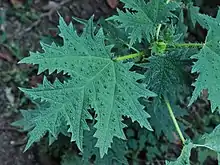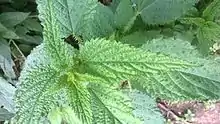Girardinia diversifolia
Girardinia diversifolia, commonly known as the Himalayan nettle[2] or Nilghiri nettle,[3] is found abundantly in open forest land, river sides, and moist habitat in Nepal and in Himalayan parts of India such as Uttarakhand, Himachal Pradesh and Jammu and Kashmir and in vast parts of China.[4] It grows naturally at elevations between 1,200 to 3,000 metres (3,900 to 9,800 feet). It is a shade tolerant, tall, stout and erect herb growing up to 3m height with perennial rootstock. The plant grows as a clump, and each clump has many stems. The stem contains bast fiber of unique quality which is strong, smooth and light.[5]
| Girardinia diversifolia | |
|---|---|
 | |
| Scientific classification | |
| Kingdom: | Plantae |
| Clade: | Tracheophytes |
| Clade: | Angiosperms |
| Clade: | Eudicots |
| Clade: | Rosids |
| Order: | Rosales |
| Family: | Urticaceae |
| Genus: | Girardinia |
| Species: | G. diversifolia |
| Binomial name | |
| Girardinia diversifolia (Link) Friis | |
| Synonyms[1] | |
| |
Allo is a 1.5 to 3 metres tall[6] perennial herbaceous shrub that grows without cultivation all over Nepal.[7] It most frequently occurs in the hilly and mountainous regions at altitudes up to 3000 m.[8]
Vernacular names
The plant is locally known as:
- Sisaun in Kumauni language
- Kandaali in Garhwali language
- 'Nepalese allo
- "Kungs" in Kullu district of Himachal Pradesh
Uses

Traditional users of Allo are ethnic groups from across Nepal, including the Kulung, Gurung, Magar, Rai and Tamang people.[9] Allo products are culturally important to both the Gurung[9] and the Rai.[8] It is also sold for commercial and non-religious purposes.[7] Non-fibre uses of the plant range from fodder and fuel wood,[8] to use as a live fence and in traditional medicines.[9] Allo fibre is very flexible and has high tenacity,[10] allowing it to be used in a multitude of applications ranging from clothing and bags to floor mats and rope.[9][11][12] Fibres made from allo are fully biodegradable.[10]
Gallery
.jpg.webp)


.jpg.webp) Inflorescence
Inflorescence Fruits
Fruits.jpg.webp)
 Seeds
Seeds
References
| Wikimedia Commons has media related to Girardinia diversifolia. |
- "The Plant List: A Working List of All Plant Species". Retrieved 14 December 2014.
- "Girardinia diversifolia". Germplasm Resources Information Network (GRIN). Agricultural Research Service (ARS), United States Department of Agriculture (USDA). Retrieved 4 September 2015.
- "BSBI List 2007". Botanical Society of Britain and Ireland. Archived from the original (xls) on 2015-01-25. Retrieved 2014-10-17.
- |url=
- Assessment of Allo Production and Enterprise Potential in Parbat District
- Singh, S.C.; Shrestha, R (1988). "Girardinia diversifolia (Urticaceae), a non-conventional fiber resource in nepal". Economic Botany. 42 (3): 445–447. doi:10.1007/BF02860167. JSTOR 4255095.
- Dunsmore, J (1998). "Microenterprise development: Traditional skills and the reduction of poverty in highland nepal". Himalaya, the Journal of the Association for Nepal and Himalayan Studies. 18 (2): 22–27.
- Barakoti, T; Shrestha, K (2008). "Commercial utilization of allo (Girardinia diversifolia) by the rais of sankhuwasabha for income generation". Banko Janakari. 18 (1): 18–24. doi:10.3126/banko.v18i1.2162.
- Gurung, A; Flanigan, H; Kumar Ghimeray, A; Karki, R; Bista, R; Gurung, O.P. (2012). "Traditional knowledge of processing and use of the himalayan giant nettle (Girardinia diversifolia (Link) Friis) among the Gurungs of Sikles, Nepal". Ethnobotany Research and Applications. 10: 167–174. doi:10.17348/era.10.0.167-174.
- Bajpai, P.K.; Meena, D; Vatsa, S; Singh, I (2013). "Tensile behavior of nettle fiber composites exposed to various environments". Journal of Natural Fibers. 10 (3): 244–256. doi:10.1080/15440478.2013.791912.
- Shrestha, R (1999). "Improvements on the traditional harvesting practice of girardinia diversifolia". Tropical Agriculture Research and Extension. 2 (1): 74–75.
- Dunsmore, J (1998). "Crafts, cash and conservation in highland nepal". Community Development Journal. 33 (1): 49–56. doi:10.1093/cdj/33.1.49.